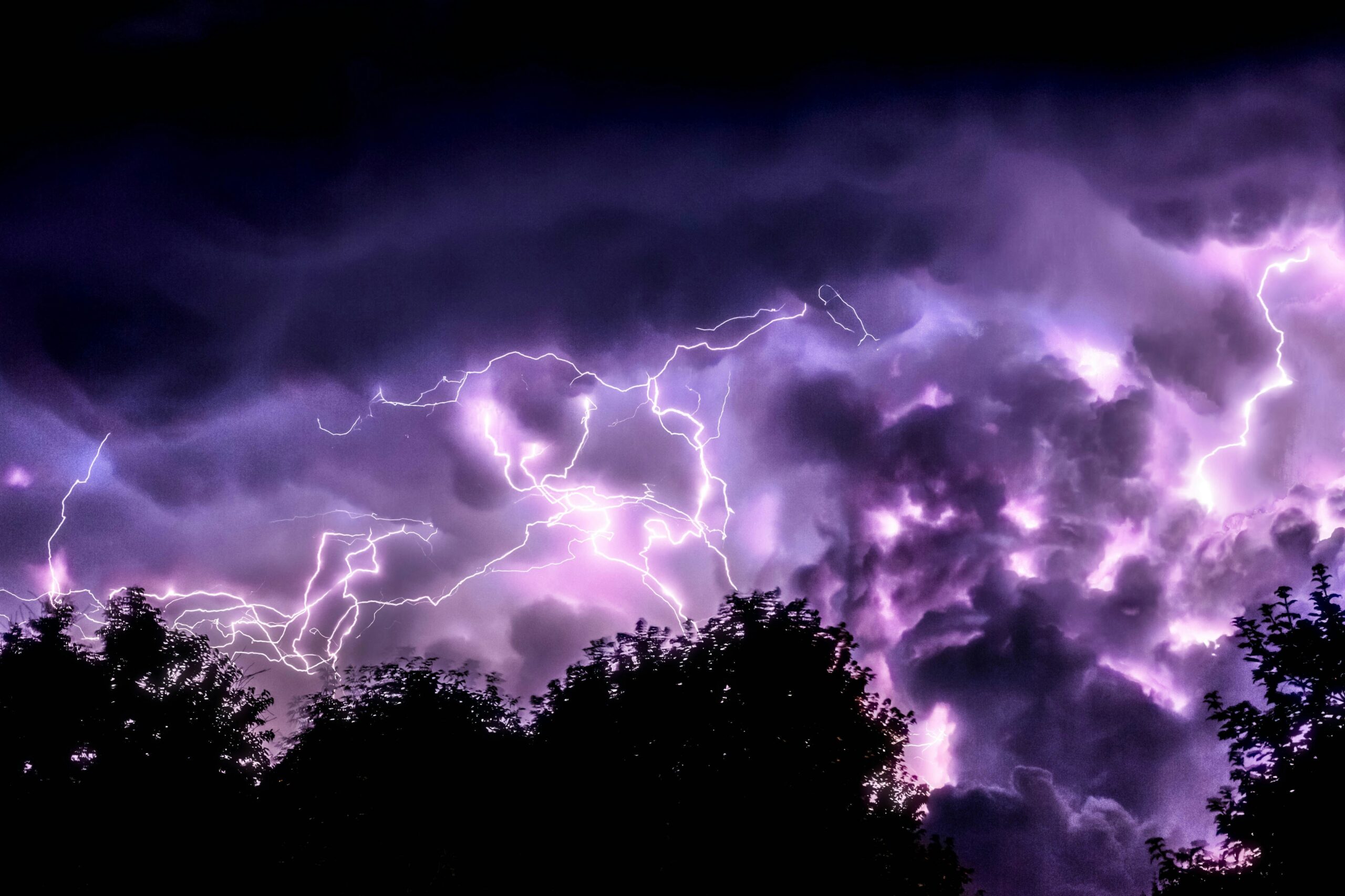Introduction to Severe Thunderstorms
Severe thunderstorms are a significant weather phenomenon characterized by specific meteorological conditions that can lead to substantial impacts on public safety and infrastructure. A severe thunderstorm is typically defined by its ability to produce one or more of the following: large hail with a diameter of at least one inch, wind gusts exceeding 58 miles per hour, and tornadoes. These storms often arise due to particular atmospheric conditions, including moisture, lift, and instability.
Moisture is a critical factor in thunderstorm development. High levels of humidity in the lower atmosphere provide the necessary water vapor to fuel storm clouds. This moisture, when lifted by mechanisms such as front lines or terrain features, condenses to form clouds and precipitation. As the moisture-laden air rises, it cools and releases latent heat, further enhancing the buoyancy of the air mass.
Lift refers to the process that forces the moist air upward. There are several sources of lift, including cold fronts, warm fronts, convection currents, and topographical influences like mountains. This upward motion is vital as it initiates the cooling and condensation process necessary for thunderstorm development. Without lift, the moisture remains near the surface, inhibiting storm formation.
Instability in the atmosphere is another crucial ingredient. It occurs when warmer air at the surface lies beneath cooler air aloft, creating a situation ripe for strong vertical updrafts. This instability can lead to the creation of powerful thunderstorms, as the rising warm air continues to accelerate upward through the cooler atmosphere. The more unstable the atmosphere, the stronger these updrafts will be, potentially resulting in severe weather conditions.
The implications of severe thunderstorms extend beyond immediate weather concerns. They can cause widespread damage to infrastructure, disrupt transportation networks, and pose significant risks to public safety. Large hail can damage vehicles and rooftops, high winds can topple trees and power lines, and lightning poses a fire hazard. Consequently, understanding the formation and characteristics of severe thunderstorms is essential for effective preparedness and response strategies.
What is a Severe Thunderstorm Watch?
A severe thunderstorm watch is a formal advisory issued by meteorological authorities, such as the National Weather Service (NWS) in collaboration with local weather stations like WMUR Weather. This advisory indicates that the atmospheric conditions within a specified region are conducive to the development of severe thunderstorms. These storms have the potential to produce large hail, damaging winds, and even tornadoes. The primary aim of a watch is to alert residents and forecasters of the possibility of severe weather, allowing ample time to prepare and take necessary precautions.
The geographical area covered by a severe thunderstorm watch is typically extensive, often encompassing several counties or even entire states. This wide coverage is due to the nature of weather systems, which can span vast areas and affect multiple locations almost simultaneously. The residents within the designated watch area should stay vigilant and keep abreast of weather updates through reliable channels, including local news broadcasts and weather apps.
It’s crucial for individuals within the watch area to understand that a severe thunderstorm watch does not guarantee the occurrence of severe weather but signifies that conditions are favorable for such developments. Therefore, readiness is key. Residents should review their emergency plans, ensure that they have access to safe shelter, and keep essential supplies like flashlights, batteries, and first aid kits handy.
Typically, a severe thunderstorm watch lasts for several hours, often ranging from four to eight hours, although it can be extended if weather conditions continue to pose a threat. Throughout the duration of the watch, continuous monitoring of the weather is recommended. Should the situation escalate, a severe thunderstorm warning may be issued, necessitating immediate action to protect life and property.
In summary, understanding the implications of a severe thunderstorm watch allows individuals and communities to take proactive steps in safeguarding themselves against potentially hazardous weather events.
What is a Severe Thunderstorm Warning?
A Severe Thunderstorm Warning is an urgent message broadcasted by meteorological authorities to alert the public of significant and potentially hazardous weather conditions that are imminent. Unlike a Severe Thunderstorm Watch, which indicates that conditions are favorable for the development of severe thunderstorms, a warning signifies that severe weather has been observed or is expected within a short time frame in a specified area.
For a Severe Thunderstorm Warning to be issued, certain criteria must be met. Primarily, the storm must exhibit characteristics such as wind gusts of 58 miles per hour (mph) or higher, hail measuring one inch in diameter or larger, or the presence of a tornado. These criteria can be identified through radar imagery that shows signs of intense storm activity or might be confirmed via ground reports from trained storm spotters or the public. The National Weather Service (NWS) utilizes advanced Doppler radar technologies to detect these severe conditions, ensuring timely and accurate warnings.
Individuals within the designated warning area should take immediate action to protect themselves and their property. Key steps include seeking shelter in a sturdy building away from windows and securing outdoor items that could become hazardous in strong winds. It is also advisable to cancel or postpone outdoor activities, keep devices fully charged, and stay informed through reliable weather sources such as WMUR Weather updates or emergency alerts.
Staying aware of Severe Thunderstorm Warnings is crucial for safety, as these warnings indicate that dangerous weather conditions are either occurring or likely to occur shortly. Proper understanding and swift action can significantly reduce personal risk and prevent damage during severe thunderstorm events.
How WMUR Weather Tracks and Reports Severe Thunderstorms
WMUR Weather employs a comprehensive array of tools and technologies to monitor and track severe thunderstorms. At the forefront of these efforts are meteorologists who leverage their expertise in conjunction with advanced radar systems, satellite imagery, and computer models to forecast and report severe weather conditions accurately.
One of the primary tools used by WMUR Weather is Doppler radar. This technology provides real-time data on storm intensity, wind velocity, and precipitation. By analyzing radar data, meteorologists can identify storm patterns, track their movement, and predict potential areas of impact. Doppler radar is essential in detecting phenomena such as hail, tornado formations, and heavy rainfall that could lead to flash flooding.
In addition to radar, satellite imagery plays a crucial role in tracking severe thunderstorms. Satellites orbiting the Earth capture images and atmospheric data, allowing meteorologists to observe cloud development, temperature changes, and moisture content on a global scale. This information is vital for understanding the broader context of severe weather systems and making more accurate predictions.
Computer models further enhance the predictive capabilities of WMUR Weather. These models simulate the atmosphere’s behavior based on current data, providing forecasts that extend from hours to days ahead. By running various scenarios, meteorologists can anticipate the development and progression of severe thunderstorms, offering critical lead time for warnings and emergency preparations.
WMUR Weather ensures that this valuable information reaches the public promptly and effectively. Through television broadcasts, the meteorologists provide detailed updates and visual explanations of current weather patterns and forecasts. Additionally, WMUR Weather utilizes mobile alerts to deliver instant notifications of severe weather warnings directly to smartphones, ensuring that individuals receive timely advisories no matter where they are. The weather team also maintains an active online presence, with frequent updates posted on their website and social media platforms to keep the community informed and prepared.
Understanding Weather Alerts: Watch vs. Warning
A fundamental aspect of weather preparedness involves understanding the difference between a thunderstorm watch and a thunderstorm warning. Grasping these differences enables individuals and communities to respond effectively to potential severe weather situations.
Firstly, a thunderstorm watch signifies that atmospheric conditions are favorable for the development of severe thunderstorms in and around the watch area. This alert is generally issued several hours before any severe weather is expected, providing ample time for preparedness. During a watch, people should remain informed by monitoring weather updates via WMUR Weather, having a plan in place, and being ready to act if conditions worsen.
In contrast, a thunderstorm warning indicates that a severe thunderstorm has either been observed by trained weather spotters or detected by radar, and it poses an imminent threat to life and property. Warnings are typically issued for smaller, localized areas and have a shorter duration compared to watches. When a warning is in effect, it is crucial to take immediate action by seeking shelter in a sturdy building, avoiding windows, and staying tuned to reliable sources like WMUR Weather for real-time updates.
Understanding the key distinctions between a thunderstorm watch and warning aids in better preparedness and response. During a watch, prioritize staying updated and planning actions without necessarily implementing emergency measures immediately. Conversely, during a warning, focus on safety by taking swift, protective actions to mitigate risk.
In assessing weather alerts, remember that watches are issued broadly and are more precautionary, while warnings demand immediate attention and action due to their specific and immediate danger. By comprehending and responding correctly to each type of alert, individuals can significantly reduce their risk and safeguard both life and property during severe weather events.
Preparedness Tips During Severe Thunderstorm Watch
When a severe thunderstorm watch is issued, it means conditions are favorable for the development of severe thunderstorms. It is crucial to take proactive steps to ensure safety and minimize potential damage. One of the most important actions is to create an emergency kit. This kit should include essential items such as non-perishable food, water, medications, flashlight, batteries, first aid supplies, and important documents. A well-prepared emergency kit can significantly enhance safety and comfort during an emergency.
Securing outdoor objects should also be a top priority. High winds associated with severe thunderstorms can turn unsecured items into dangerous projectiles. Items such as patio furniture, garden tools, and bicycles should be brought indoors or securely tied down. Additionally, it is advisable to trim trees and shrubs to prevent branches from breaking and causing damage during high winds.
Reviewing and updating emergency plans is another critical step. Families should have a clear communication plan in place. This includes knowing how to contact each other and where to meet if separated. It is also essential to identify a safe shelter location within the home where all family members can go during a storm. Basements or interior rooms without windows are typically the safest places.
Staying informed through reliable weather sources is paramount during a severe thunderstorm watch. Regularly monitor weather updates from trusted sources such as WMUR Weather, which provide accurate and timely information. Weather apps, NOAA Weather Radio, and local news outlets are also excellent resources for staying updated on current conditions and potential changes in weather alerts.
By following these preparedness tips, individuals and families can better ensure their safety and minimize the risks associated with severe thunderstorms. Preparing in advance and staying informed are key components of weather readiness.
Immediate Actions During a Severe Thunderstorm Warning
When a severe thunderstorm warning is issued, it is imperative to take immediate actions to ensure the safety of yourself and those around you. The following guidelines, based on insights from WMUR Weather, outline what to do in different scenarios—whether you are indoors, outdoors, in a vehicle, or at places such as schools or workplaces.
If You Are Indoors
Immediately seek shelter in a safe, enclosed space. Stay away from windows, doors, and outside walls. The safest location would be an interior room or basement on the lowest floor of the building. Use heavy furniture for cover if necessary. Avoid using electrical appliances and avoid water during the storm since lightning can travel through plumbing and electrical wiring.
If You Are Outdoors
Seek shelter indoors as quickly as possible. If there are no buildings nearby, look for lower ground, such as a ditch, but be mindful of the potential for flooding. Avoid high areas, isolated trees, and metal objects, which can attract lightning. If shelter is not accessible, crouch down with your feet together, making yourself as small a target as possible, and cover your head.
If You Are in a Vehicle
Do not attempt to outrun a severe thunderstorm in a vehicle. Pull over to a safe location away from trees and power lines that could fall on the vehicle. Remain inside with seatbelts fastened, and avoid touching metal parts inside the car. If possible, position the car away from bodies of water that might flood.
At Schools or Workplaces
Follow the established emergency plans and procedures quickly. Move to designated storm shelters or interior rooms away from windows. Teachers and supervisors should account for all individuals and maintain a calm and orderly environment while waiting for the storm to pass. Keep everyone informed with updates from weather alerts or emergency services.
Understanding and following these immediate actions during a severe thunderstorm warning can mitigate risks and enhance safety for everyone involved. Always prioritize seeking shelter and staying informed through reliable sources like WMUR Weather.
Conclusion and Resources
In today’s rapidly changing climate, understanding the distinction between a severe thunderstorm watch and a severe thunderstorm warning is crucial for public safety. Throughout this blog post, we’ve delved into the fundamental differences between these two alerts. A severe thunderstorm watch signifies that conditions are favorable for severe thunderstorms to develop, warranting increased vigilance and preparedness. In contrast, a severe thunderstorm warning indicates that severe weather is imminent or occurring, necessitating immediate protective actions.
Comprehending these differences can significantly mitigate risks and enhance individual preparedness during severe weather events. It is critically important to stay informed through reliable sources like WMUR Weather to receive timely updates about severe weather conditions. WMUR Weather provides valuable insights and real-time data that can help the public make informed decisions.
For those seeking further information, several resources are available to deepen your understanding and enhance your preparedness against severe weather threats:
• WMUR Weather: Stay updated with the latest weather conditions, forecasts, and severe weather alerts.
• National Oceanic and Atmospheric Administration (NOAA): Access comprehensive weather data, forecasts, and educational resources.
• Federal Emergency Management Agency (FEMA): Learn about emergency management procedures and safety measures.
• Local Emergency Management Agencies: Get detailed information on localized emergency plans and resources in your area.
By utilizing these resources and understanding the distinctions between a watch and a warning, you can better protect yourself, your family, and your community from the impacts of severe thunderstorms. Stay informed, stay prepared, and prioritize safety above all.


